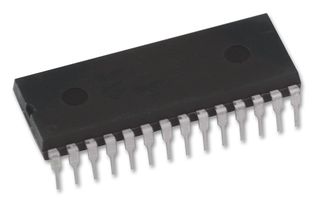DS1210
The ADS1210 , wide dynamic
range, delta-sigma Analog-to-Digital (A/D) converters with
24-bit resolution operating from a single 5V supply. The
differential inputs are ideal for direct connection to transducers or low-level voltage signals. The delta-sigma architecture is used for wide dynamic range and to ensure 22 bits
of no-missing-code performance. An effective resolution of
23 bits is achieved through the use of a very low-noise input
amplifier at conversion rates up to 10Hz. Effective resolutions of 20 bits can be maintained up to a sample rate of
1kHz through the use of the unique Turbo modulator mode
of operation. The dynamic range of the converters is further
increased by providing a low-noise programmable gain
amplifier with a gain range of 1 to 16 in binary steps
DS1230Y120
10 years minimum data retention in the
absence of external power
? Data is automatically protected during power
loss
? Replaces 32k x 8 volatile static RAM,
EEPROM or Flash memory
? Unlimited write cycles
? Low-power CMOS
? Read and write access times of 70 ns
? Lithium energy source is electrically
disconnected to retain freshness until power is
applied for the first time
? Full ?10% VCC operating range (DS1230Y)
? Optional ?5% VCC operating range
(DS1230AB)
? Optional industrial temperature range of
-40?C to 85?C, designated IND
? JEDEC standard 28-pin DIP package
DS1232L
Super-low power version of DS1232
50 ?A quiescent current
Halts and restarts an out-of-control
microprocessor
Automatically restarts microprocessor after
power failure
Monitors pushbutton for external override
Accurate 5% or 10% microprocessor power
supply monitoring
8-pin DIP, 8-pin SOIC or space saving ?-SOP
package available
Optional 16-pin SOIC package available
Industrial temperature -40?C to 85?C
available, designated N
DS1233Z-10
The DS1233 EconoReset monitors two vital conditions for a microprocessor: power supply and external
override. A precision temperature-compensated reference and comparator circuit are used to monitor the
status of the power supply (VCC). When an out-of-tolerance condition is detected, an internal power-fail
signal is generated which forces reset to the active state. When VCC returns to an in-tolerance condition,
the reset signal is kept in the active state for approximately 350ms to allow the power supply and
processor to stabilize. The second function of the DS1233 is pushbutton reset control. The DS1233
debounces a pushbutton closure and will generate a 350ms reset pulse upon release.
DS12885S
? Drop-In Replacement for IBM AT Computer
Clock/Calendar
? RTC Counts Seconds, Minutes, Hours, Day, Date,
Month, and Year with Leap Year Compensation
Through 2099
? Binary or BCD Time Representation
? 12-Hour or 24-Hour Clock with AM and PM in
12-Hour Mode
? Daylight Saving Time Option
? Selectable Intel or Motorola Bus Timing
? Interfaced with Software as 128 RAM Locations
? 14 Bytes of Clock and Control Registers
? 114 Bytes of General-Purpose, Battery-Backed
RAM (113 Bytes in the DS12C887 and
DS12C887A)
? RAM Clear Function (DS12885, DS12887A, and
DS12C887A)
? Interrupt Output with Three Independently
Maskable Interrupt Flags
DS1305
The DS1305 serial alarm real-time clock provides a full binary coded decimal (BCD) clock calendar that
is accessed by a simple serial interface. The clock/calendar provides seconds, minutes, hours, day, date,
month, and year information. The end of the month date is automatically adjusted for months with fewer
than 31 days, including corrections for leap year. The clock operates in either the 24-hour or 12-hour
format with AM/PM indicator. In addition, 96 bytes of NV RAM are provided for data storage. The
DS1305 will maintain the time and date, provided the oscillator is enabled, as long as at least one supply
is at a valid level.
DS1620S
The DS1620 Digital Thermometer and Thermostat provides 9?bit temperature readings which indicate
the temperature of the device. With three thermal alarm outputs, the DS1620 can also act as a thermostat.
THIGH is driven high if the DS1620?s temperature is greater than or equal to a user?defined temperature
TH. TLOW is driven high if the DS1620?s temperature is less than or equal to a user?defined temperature
TL. TCOM is driven high when the temperature exceeds TH and stays high until the temperature falls
below that of TL.





















